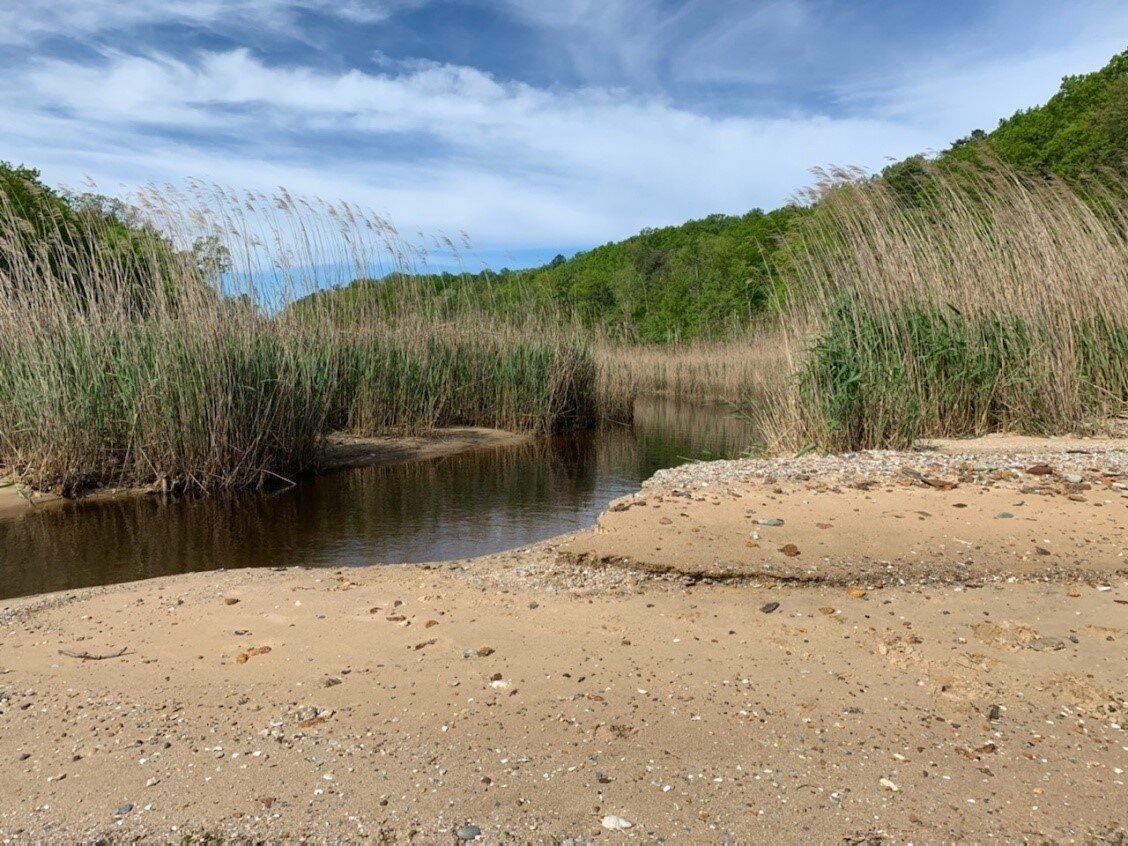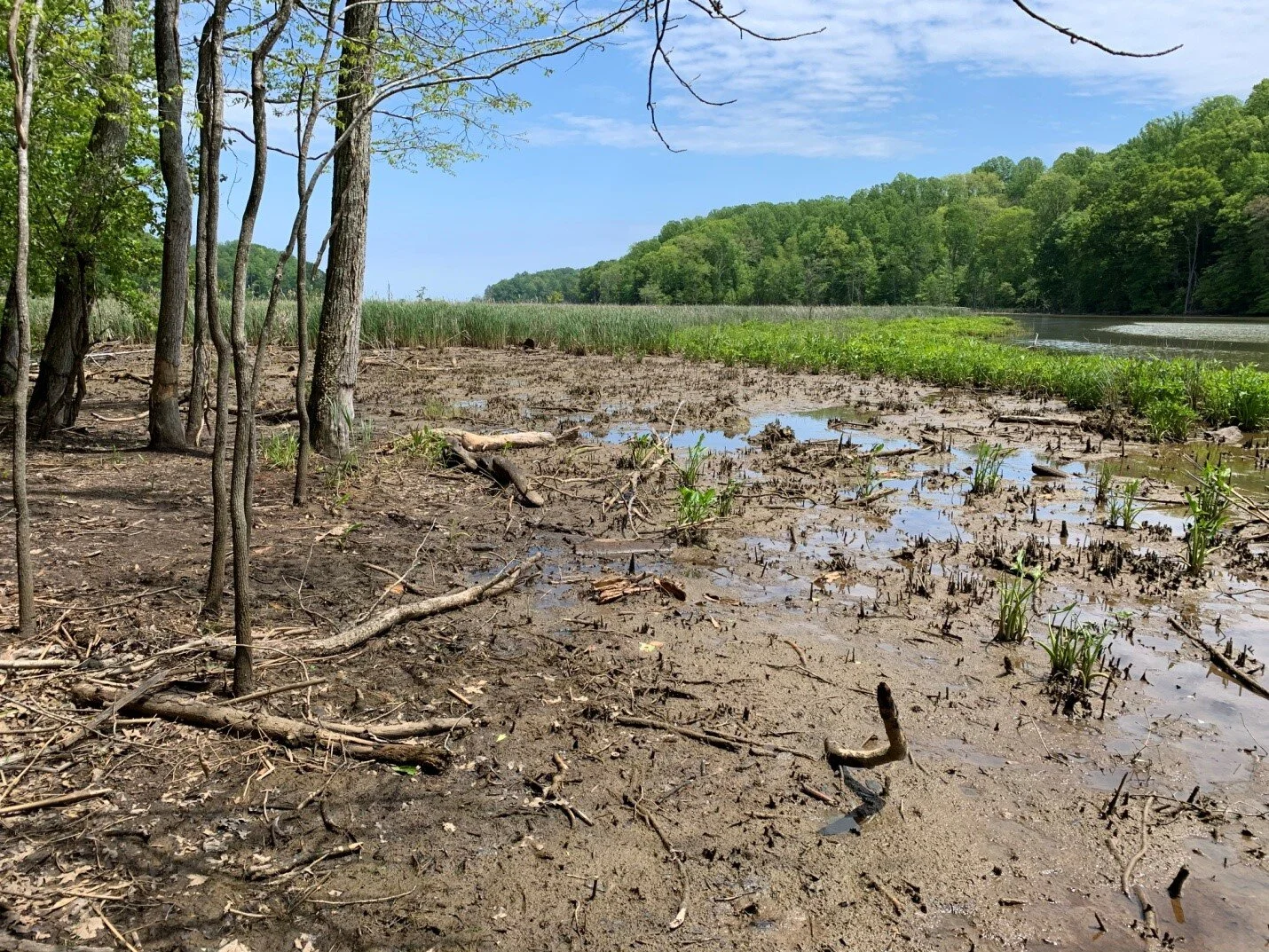Phragmites australis, commonly phragmites, is an invasive reed that was first introduced to the United States from Europe over 200 years ago. Although phragmites was among the first visitors to the new America, it wasn't until the 1960's-1980's that it began rapidly invading wetlands throughout the entire Atlantic coast. The Smithsonian Environmental Research Center has investigated the mechanisms behind this sudden expansion and hypothesizes it is due to the establishment of multiple phragmites genotypes in close proximity to one another. They found that by having multiple genotypes among a patch, phragmites was able produce a large number of viable seeds which enabled it to spread rapidly.
Invasive phragmites along the shores of the Chesapeake Bay at the Calvert Cliffs State Park in Lusby, Maryland.
There is a subspecies of phragmites that is native to the United States. At one point you could find it interspersed harmoniously with other native vegetation throughout wetlands. However, the invasive phragmites and native phragmites have hybridized over the years. Invasive phragmites has more aggressive genotypes than the native strands, causing the DNA of the native phragmites to become overpowered by its non-native counterpart. Currently, the invasive phragmites is taking over entire marsh ecosystems. Not only does it create a monoculture that outcompetes native vegetation and provides little food or nesting resources for native wildlife, but it also impairs recreational opportunities and viewshed experiences.
So, what is being done to control phragmites? Herbicide applications, animal grazing, and heavy machinery removal are currently among the most popular control options, though solarization is proving to be an exciting new method for effective phragmites control. Herbicide applications have been successful at phragmites removal to some extent but usually involve between three and five years of consecutive treatments. Additionally, the herbicide applied not only affects the phragmites, but if applied in large quantities, it can also affect other aquatic life and water quality. Furthermore, there has been little success with the reestablishment of native vegetation once the herbicide has been applied and the phragmites is gone.
Using heavy machinery to remove phragmites disrupts the wetland ecosystem by removing the marsh soil and creating disturbed paths on the way to the water’s edge. Animal grazing is one of the least disturbing methods of control; however, there are only so many instances where this is feasible. For example, the wetland would need to be surrounded by pasture or have soil that is stable and topography that is mild enough to support animal access. Additionally, it may be difficult to limit the grazing to invasive phragmites and avoid negative impacts on other native grasses that provide important benefits such as filtering water, buffering the impacts of flooding events, and supplying important food and nesting habitat for wildlife.
Implementation of the solarization treatment after the phragmites was cut and plastic laid. Note the use of white plastic during an initial solarization experiment. The black plastic was found to hold up better during the solarization treatment.
Solarization has received little attention in the literature world as an effective means for eradication. However, knowledge on the ecology of phragmites and the scope of prior experiments helps shed light on why this might be. Phragmites primarily propagates through a vast network of underground rhizomes. It also can disperse through seeds in early fall, but its ability to spread underground is far more successful. Phragmites also falls slightly behind other native wetland vegetation in terms of life cycle. While plants such as cattails are beginning new growth after the first frost, phragmites is still lying dormant. Therefore, aboveground removal is much more effective if it is completed after phragmites has sent all of its energy stores into its aboveground biomass. Further, it is imperative that removal efforts also tackle the belowground rhizome network to be 100% effective. Most solarization experiments that are cited in the literature have been limited in scope due to the significant upfront time and financial commitment that is necessary to make them successful. Instead of treating an entire patch and allowing enough time for solarization to heat the soil, most experiments have only covered small patches located within larger ones and left plastic on for a period of 6-8 weeks. Unfortunately, solarization, or any removal technique, would have little success in this instance because once the removal is complete the surrounding phragmites will have no problem reinvading before native vegetation can establish.
Solarization site immediately after the plastic was removed.
So, what is involved with the successful implementation of the solarization technique? Solarization utilizes the sun’s ultraviolet rays to heat the soil to temperatures which are detrimental to the underground phragmites rhizome network. This is done by laying thick black plastic over cut patches of phragmites which traps the heat and kills the rhizomes. Therefore, it is crucial to get the plastic on during the hottest months of the year. Although it is recommended to leave the plastic on a minimum of 6 weeks, we have found the longer, the better. Additionally, the use of black plastic prevents sunlight from reaching the phragmites making it unable to complete photosynthesis to generate the energy it needs to re-grow. This depletes the energy stores in the rhizomes and, combined with the increased soil temperatures, completely kills the phragmites. Once spring arrives the black plastic can be removed, and if placed properly, can be reused for future removal efforts.
The same site after solarization implementation showing early regrowth of native vegetation.
To date, we have seen almost 100% eradication and almost no phragmites re-growth after just one year of solarization treatment. While solarization is more time and labor intensive, and therefore more financially costly upfront, it is a one time cost and has been much more effective at phragmites control than common methods like herbicide application. This means that you will achieve eradication much more quickly with the solarization method and will avoid the addition of herbicide to the ecosystem. Perhaps what is most astonishing about the solarization method is that phragmites re-growth at the site has been almost non-existent while native plants have begun to re-establish on the sites just 1-2 years after the solarization treatment was completed.
2 years after solarization treatment showcasing the re-establishment of native vegetation.
The owners of EcoHaven, LLC have successfully implemented solarization in a wetland along the western shore of the Chesapeake Bay. The patches of phragmites were isolated and surrounded by a diversity of native plants. Therefore, once the plastic was removed, the surrounding native vegetation was able to repopulate the site without the need of a supplemental planting. At EcoHaven, LLC we believe solarization is the best method for phragmites control currently available. While most people may stray away from the intense manual labor required, we revel in the sweat and marvel at the beauty once all is said and done. We would love to help you save your marsh ecosystem, and if financial constraints are keeping you away, contact us about finding unique financial solutions.









